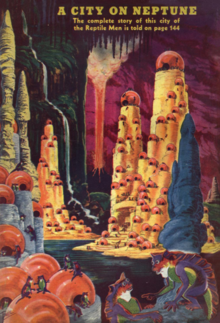Neptune in fiction

Neptune
Early depictions
The first time Neptune was mentioned in a work of fiction—then called "Leverrier's planet" after astronomer Urbain Le Verrier whose orbital calculations led to the planet's discovery—was in the 1848 novel The Triumphs of Woman by Charles Rowcroft where an inhabitant of the planet visits Earth.[9] Neptune was usually omitted in the subgenre of works visiting multiple locations in the Solar System that appeared in this time, though it did make some indirect appearances in works not otherwise set there.[9] Supernatural communication with its inhabitants appears in Marie Corelli's 1892 novel The Soul of Lilith.[9][10] In the 1897 short story "The Star" by H. G. Wells, an impact event causes Neptune to turn into a star and puts it on a collision course with Earth.[9][11] In Robert William Cole's 1900 novel The Struggle for Empire: A Story of the Year 2236, described by science fiction scholar E. F. Bleiler as the first space opera and by Westfahl as the first appearance of a galactic empire, the vicinity of Neptune is the site of a battle between the British Empire that has come to rule the Solar System and the forces of a rival empire centered on Sirius.[9][12][13]
Early works incorrectly depicted Neptune as a
The most significant appearance of Neptune in fiction in this era is in the 1930 novel
Later depictions
[Gardner Dozois] didn't mind that there were elephants on Neptune, or that they breathed oxygen, or that they could speak English, or that they could forage and find food—but it bothered the hell out of him that I'd given Neptune a solid surface when everyone knows it's a gas giant, so I had to insert a sentence explaining that.
Mike Resnick, on selling the 2002 short story "The Elephants on Neptune" to Asimov's Science Fiction[18]
Once more became known about Neptune through advances in
Triton
Neptune's largest moon
See also

References
- ^ a b c d e f Langford, David; Stableford, Brian (2021). "Outer Planets". In Clute, John; Langford, David; Sleight, Graham (eds.). The Encyclopedia of Science Fiction (4th ed.). Retrieved 2021-11-04.
Neptune, like Uranus, makes only relatively rare sf appearances except as part of a Grand Tour.
- ^ ISBN 978-1-4408-6617-3.
since these worlds have reasonably been viewed as cold and inhospitable, they have generally been underutilized as settings for science fiction stories.
- ^ OCLC 2984418.
Neptune has been largely overlooked in the genre
- ^ ISBN 978-3-642-55343-1.
- ISBN 978-0-87338-416-2.
- ISBN 978-0-87338-604-3.
- ISBN 978-1-4766-8659-2.
- ^ ISBN 978-0-313-32951-7.
- ^ ISBN 978-0-415-97460-8.
- ISBN 978-0-87338-416-2.
- ISBN 978-0-87338-416-2.
- ISBN 978-0-87338-416-2.
- ISBN 978-1-4408-6617-3.
- ^ ISBN 978-0-684-84958-4.
Very few alternativersal versions of Neptune—even among those reported in the earliest days of imaginative exploration—feature an active ecosphere, the principal exceptions being located in two notable alternativerses in which Neptune became a significant refuge for human life following the expansion of the senescent sun.
- ISBN 978-0-87338-604-3.
- ISBN 978-0-87338-604-3.
- ^ Ashley, Mike; Clute, John (2022). "Stapledon, Olaf". In Clute, John; Langford, David; Sleight, Graham (eds.). The Encyclopedia of Science Fiction (4th ed.). Retrieved 2023-04-30.
- ISBN 978-1-59224-019-7.
- ^ Nicholls, Peter (2023). "Delany, Samuel R". In Clute, John; Langford, David; Sleight, Graham (eds.). The Encyclopedia of Science Fiction (4th ed.). Retrieved 2023-12-26.
- ^ Fraknoi, Andrew (January 2024). "Science Fiction Stories with Good Astronomy & Physics: A Topical Index" (PDF). Astronomical Society of the Pacific (7.3 ed.). p. 13. Archived (PDF) from the original on 2024-02-10. Retrieved 2024-03-16.
- ISSN 0198-6686.

